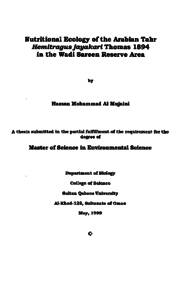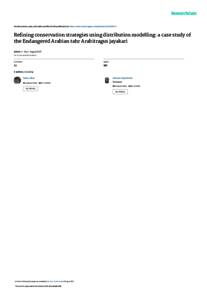Document
Nutritional ecology of the Arabian Tahr hemitragus jayakari Thomas 1894 in the Wadi Sareen reserve area.
Publisher
Sultan Qaboos University
Gregorian
1999
Language
English
English abstract
The feeding ecology of the Arabian tahr Hemitragus jayakari was evaluated in the Wadi Sareen Reserve. Faecal analysis was used to ascertain and quantify the diet eaten by tahr and to estimate the range nutritional quality. Faecal material was collected in the period between October 1997- June 1998 in six field visits. The diet was quantified by using microhistological identification of plant species cuticular fragments in faeces. Fragments identified in faeces were compared to a reference collection of cuticles of plants collected from the study area in the reserve. The nutritional quality was estimated by evaluating faecal components of nitrogen, fibre and minerals. Faecal nitrogen (FN) was estimated as an indicator of dietary crude protein using the Kjeldal method. Faecal fibre was estimated as an indicator of dietary fibre using neutral detergent fibre-NDF, acid detergent fibre-ADF, and acid detergent lignin methods. Faecal total ash method was used to estimate the total mineral components of the diet. Faecal material for semi-feral goats that were found roaming in the reserve was also collected during the last two visits. This was done to evaluate any diet competition caused by the presence of these herbivores in tahr habitat. The diet composition estimated from faecal analysis indicated that Arabian tahr are predominantly mixed (generalist) feeders. Of the total epidermal fragments identified throughout the study period monocotyledons and dicotyledons represented 46.5% and 53.5% respectively. The diet was found to consist of a mixture of grasses, perennial trees, shrubs and herbs. Thirty-three dicotyledons were identified in the faeces while only four monocotyledons were positively identified. Analysis of goat faeces collected during fifth and sixth field visits showed that there is a great similarity between tahr and goat diet. Goats shared a total of 30 plant species with tahr. The plant species composition of tahr diet seems to follow the rainfall pattern, During rainy seasons the amount of monocotyledons identified in tahr faeces increased and the amount of dicotyledons decreased. The opposite trend occurred during dry period. This was supported by the seasonal variation in the FN and fibre. At the end of the rainy season i.e. during the third field visit) FN was found to have reached its highest level and faecal fibre (NDF, ADF, and lignin) have reached its lowest level. This suggests that the amount and type of diet eaten is probably a function of forage availability and quality. The highest FN recorded was 11.1% at the end of the rainy season and the lowest was 8% during a dry period. Dicotyledons (e.g. trees) generally maintain high crude protein levels even during dry periods and in this study were found to represent a substantial part of tahr diet. Therefore, tahr do not suffer nutritional stress as far as the availability of protein is concerned. This study has confirmed the potential for competition between tahr and domestic goats in habitat. However, the extent of competition could not be measured due to the lack of sufficient data. The protection of the right habitat and the exclusion of any competition is a major step in the conservation of the Arabian tahr.
Member of
Resource URL
Category
Theses and Dissertations


